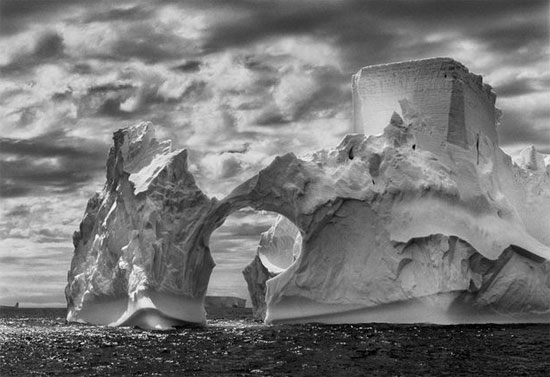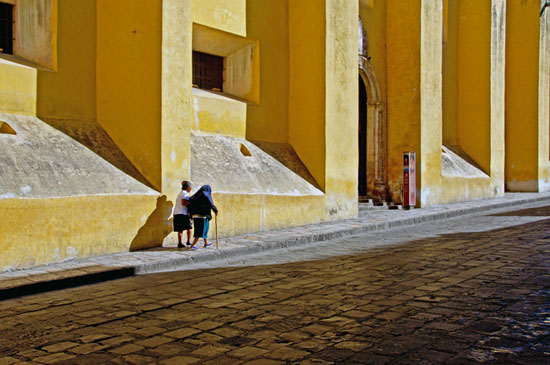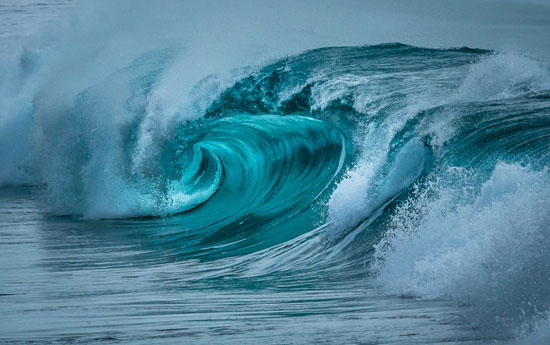The luminous landscape culture is a large yet oddly cloistered group of Romantic landscape photographers who work outside of the contemporary art scene by mutual disinterest. Recently there have been some art world overlaps, as seen in the dramatic prints of Sebastião Salgado in his current “Genesis” exhibit at the International Center of Photography in Manhattan. And a more modest version of this culture is currently on view in the form of 22 prints by James Slezak on display at the Hamptons Bays Public Library in the exhibition “Mostly Hampton Bays—Photography of James Slezak”.
.

Photograph by Sebastião Salgado.
.
Typically regionally oriented, luminous landscape imagery tends to have a flavor intrinsic to the selected environs. The photographers are a dedicated crowd, rising at 4 a.m. to hump up a hill with 30 pounds of gear in order to the memorialize the raking morning light, a la the late Ansel Adams. The results are generally too beautiful for the nature morte mood of the art world, in which nature itself is apparently considered somehow tacky.
There are quite a few luminous landscape photographers on the East End, devoted to similar regional images of seashore and seascapes. Slezak distinguishes himself as having a good eye, as evidenced by his study of Ponquogue Beach, as well as the ever increasing resonance of his images in general. Many of his images are good enough for book covers, major magazines, or even art galleries, and one of San Miguel de Allende in Guanajuato, Mexico, was reproduced in The New York Times.
.

Photograph by James Slezak. San Miguel de Allende, Mexico.
.
The cover image of Slezak’s brief catalog for the library exhibition is titled Sand Ripple Incursion and it is a photographer’s dream shot: at once abstract with op-art ripples in the wind-driven sand drifting over a peacock blue mat, but also figurative as both elements are recognizable.
.

"Sand Ripple Incursion" by James Slezak, July 2014.
.
There are lots of wave shots available in East End galleries and they tend to bore quickly. The few I’ve seen from Slezak, though, endure with their special light, much like a Turner marine painting. It's a hard subject to do fresh, and few accomplish it. My brother Tom Croak’s photos of the surf at Papohaku Beach on the west end of the island of Molokai and Slezak’s open sea shots, I would say, are tied for first place in this sub-genre.
.

Photograph by Tom Croak. Papohaku beach, Island of Molokai. Shot with a F2.8 300 Canon prime.
.
That said, Slezak is being held back by a few easily corrected issues, minor missteps that seem to be common in this area.
First, prints today are measured in feet, not inches as they were 30 years ago. The timid sizing of the Slezak’s prints was especially bothersome, as were the overbearing frames: the viewer has to peer at the prints from a foot or two away to appreciate them. These images were not torn from some 1870s book of daguerreotypes, and should be larger.
German photographer Andreas Gursky, the current big ticket darling on the international auction circuit, prefers to print 11 feet wide by 6 feet, 9 inches tall. Sitting or standing in front of his massive prints is a singular art experience, often a group experience. One such photo, Rhein II, sold at Christie’s for $4,338,500. Slezak needn’t go to 11 feet, but 3 feet would increase the effect, and 4 would be even better.
.

Andreas Gursky installation shot.
.
Printing this large means not printing at home, which is also considered old hat nowadays. Maintaining a complicated ink-clotting printer has given way to a much more efficient method. Professional landscape photographers across America are now using such printing services. Think Costco, which prints to 30 inches wide for peanuts and up to 60 inches wide on a selection of materials, or uber-expensive but ultimately perfect Laumont Studio on 52nd Street in Manhattan, or Hampton Photo Arts in Bridgehampton, where photographers routinely get better results with greater color saturation and typically lower cost than desktop printing.
Secondly, the 12M D90 Nikon used by Slezak to make most of his photos has an unusually low pixel count by today’s standards. Printing native, it is limited to book size prints and is insufficient for mounting contemporary photography shows. Sony’s A7r at 36 megapixels is becoming the new standard for landscape photography, For those who want to keep the Nikon glass, a good choice is to move up to the D810e, a promising landscape box that uses the same Sony sensor.
Zoom lenses are a good choice for photographing action, not landscape. While some of Slezak’s work seems to be done with prime—fixed focal length—lenses, many have that suspicious, lazy, almost-in-focus, unsaturated zoom look.
If the target is Gisele Bündchen bussing Tom Brady in between throwing touchdown passes, the one-size-fits-all zoom is the right lens, but for landscape work, photographers have a built in zoom: it’s called “legs,” which can yield different perspectives and angles with simple movement. Any prime is better than the best zoom. Croak’s wave shots, for example, are done with an F2.8 300mm prime, and the colors glimmer off the wall.
Last on the gearhead harangue is the tripod. The difference between a snapshot and a photograph is the tripod, and that should be as rigid and unmovable as humanly possible. I didn’t have the impression Slezak was using a good one. A vibration the width of a human hair at the camera is magnified to two inches at 500 feet; and even the shutter curtain will vibrate that much.
The landscape community consensus is Really Right Stuff tripods. These are ludicrously expensive but the results are noticeable and would improve Slezak’s or any landscape photographer’s images. (The insiders’ joke is that there are two ways to buy one: 1. buy and dispose of five others first; 2. buy one.)
In general, Slezak has already done most of the learning curve, with good results. With a little tweaking of equipment and printing, it’s likely we will see many more of his shots in The New York Times and similar publications.
.

"Orange Balloon" by James Slezak, August 2014.
.
BASIC FACTS: “Mostly Hampton Bays—Photography of James Slezak” is on view through November 30, 2014 at the Hampton Bays Public Library, 52 Ponquogue Avenue, Hampton Bays, NY 11946. www.jamesslezakphotography.com.
___________________________
Copyright 2014 Hamptons Art Hub LLC. All rights reserved.
